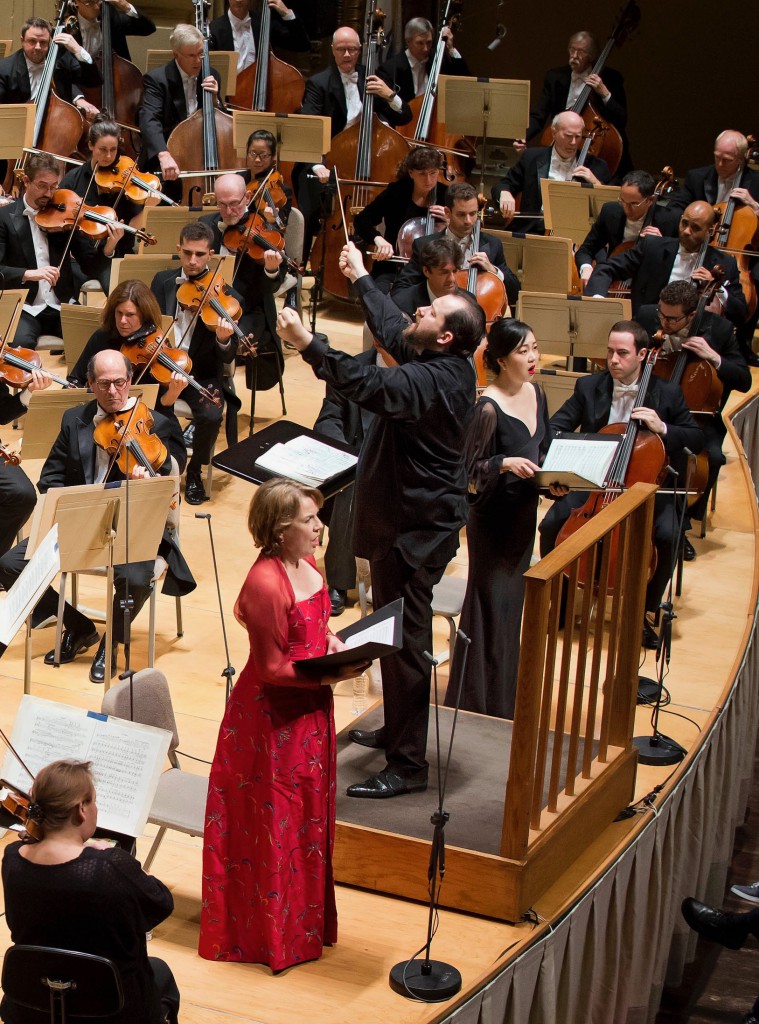Nelsons’ Mahler mastery on display in BSO’s heavenly “Resurrection” symphony

Andris Nelsons conducted the Boston Symphony Orchestra in Mahler’s Symphony No. 2 with soloists Bernarda Fink and Ying Fang Thursday night. Photo: Winslow Townson
Two years ago, the manuscript of Gustav Mahler’s Symphony No. 2 was sold at Sotheby’s for 4.5 million pounds to a buyer who continues to remain anonymous. The purchase of the score for such a record-breaking sum is an ironic twist given the symphony’s theme.
For even though the document — once owed by controversial Mahler enthusiast Gilbert Kaplan — only moved in the circles of the very rich, the message captured in its ink strokes speaks to the masses. In Mahler’s depiction of the afterlife, which he articulated in this work, all people return to the divine as equals. As he stated in his program for this “Resurrection” Symphony, “There are no sinners, no just.” The thrust of the score comes in its conclusion, where Mahler, drawing upon the writing of poet Friedrich Gottlieb Klopstock as well as his own verse, portrays a vivid view of heavenly bliss.
When the Boston Symphony Orchestra and the Tanglewood Festival Chorus, led by Andris Nelsons, reached this section of the symphony Thursday night at Symphony Hall, Mahler’s vision rang clearly and offered solace in the face of the kind of Nietzschean pessimism that pervades our often profane times.
In his five years as music director of the BSO, Nelsons’ approach to Mahler’s music has only deepened. Though his early outings with the orchestra in the composer’s Sixth Symphony tended to focus too much on the details, he has since arrived at a firm sense of direction and momentum that makes the music come alive. Details, though, are aplenty in Mahler’s world-embracing Second, but Nelsons sculpted each phrase to fit within a larger, teleological whole. Tempo shifts, though occasionally abrupt, never felt jarring or out of place.
The first movement’s funeral march was dark and brooding. Throughout its 24-minute length, the music churned urgently whenever the main theme recurred. Contrasts were bold. The second theme glowed softly in the strings and winds, while solo English horn and oboe cast a brief pastoral scene.
Nelsons took the five-minute pause—which Mahler intended—at the close of the first movement. But when he awkwardly addressed the audience to explain the tradition, which is often unobserved these days, the chatter and laughter in the hall killed any seriousness the composer had intended for the moment.
Once the music was again underway, a feeling of reverence returned. The graceful, sunny string melodies of the second movement played like friendly conversation, a cheery diversion from the symphony’s death-haunted opening. Fleet tempos added a slight touch of agitation to the chamber-like textures of the second theme.
Nelsons made the most of the third movement’s slithering melodies and Klezmer-like solo clarinet passages. Shaped with well-placed crescendos, the melodies unfolded into a cataclysmic chord, a piercing death shriek that cut through the air before the music ebbed away.
The “Urlicht” movement, based on a text from Des Knaben Wunderhorn, featured mezzo-soprano Bernarda Fink in light-toned but yearning lines. She had a fine partner in soprano Ying Fang, and both singers floated searching, radiant phrases in the final movement’s “O Glaube.”
The Tanglewood Festival Chorus, prepared by James Burton, sang its part in the finale with hushed intensity and a diction of crystalline clarity. The final chorus, with its certitude that the dead will rise again, produced a triumphant conclusion. Death, as this performance suggested, is merely a doorway into Mahler’s vivid eternity.
To open the concert, Burton led the chorus in the Boston premiere of Maija Einfelde’s Lux Aeterna, which commemorated the 100th anniversary of Latvian independence. Einfelde, like Nelsons, is Latvian, and her music possesses the same intimacy and broadly tonal style as does that of her popular compatriot, Ēriks Ešenvalds.
Throughout its six-minute length, Lux Aeterna makes for intriguing listening. Harmonies crystalize into thorny dissonances, textures are by turns knotty and serene, yet the primary vocal line soars gently and clearly overhead. Crotales added a splash of light to Burton’s supple and delicately shaded reading.
The program will be repeated 8 p.m. Saturday and Tuesday at Symphony Hall. bso.org; 888-266-1200
Posted in Performances




